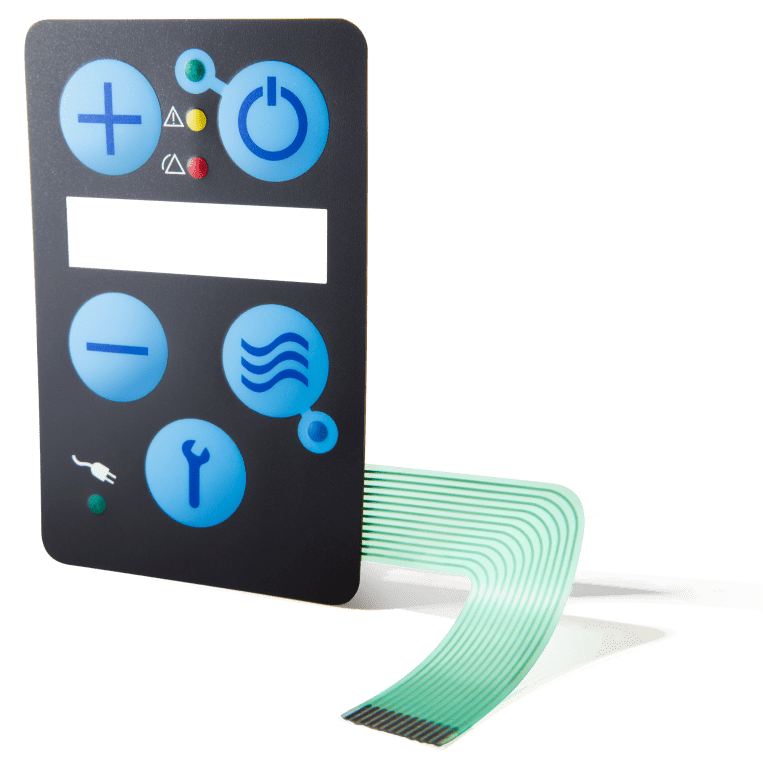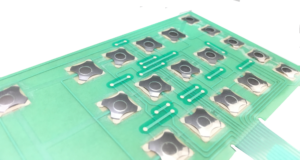Comprehending the Significance of Membrane Switches in Interface
Membrane switches are integral elements in the design of reliable user interfaces, facilitating not just functionality yet also boosting aesthetic allure and user communication. Their unique attributes, such as resistance to adjustable designs and environmental variables, make them appropriate for a diverse selection of applications across several sectors. As we check out the future fads and different benefits related to Membrane technology, it ends up being clear that these buttons are greater than just parts; they represent a convergence of technology and usefulness. The effects of this technology on individual experience deserve examining even more.
What Are Membrane Switches?

The spacer layer, which contains glue residential or commercial properties, allows for the separation of the circuit layer from the overlay, making certain that the button stays in a non-activated state until pressed. When pressure is related to the overlay, it presses the spacer layer, connecting the space and completing the circuit in the underlying layer. This layout not just decreases the physical space needed for standard mechanical switches but additionally improves the toughness of the gadget, as Membrane buttons are typically immune to dust, moisture, and other ecological elements.
Commonly located in applications ranging from customer electronic devices to medical tools, Membrane buttons are indispensable to contemporary technology, supplying a easy to use and efficient user interface that aligns with modern design needs.
Benefits of Membrane Buttons
While numerous button technologies exist, Membrane Switches offer unique benefits that make them especially preferable in different applications. Among the primary advantages of Membrane buttons is their small layout, which permits space-saving applications in tools where realty is restricted. Their thin account not only improves visual allure but likewise facilitates lightweight building and construction.
Another significant advantage is their resistance to environmental variables. Membrane switches are normally secured against wetness, dirt, and impurities, making them suitable for usage in requiring environments, such as medical gadgets and commercial tools. This sturdiness prolongs the life-span of the button, reducing maintenance expenses and enhancing integrity.
In addition, Membrane buttons can be personalized to fulfill particular style demands, including unique graphics and shades that enhance individual interaction. Their tactile comments choices can likewise be customized to give a satisfying user experience. Additionally, Membrane buttons are cost-effective, particularly in high-volume applications, as they can be produced efficiently.
Applications in Various Industries

In the customer electronics sector, Membrane buttons are widespread in gadgets such as microwaves, washing equipments, and push-button controls. Their tactile responses and aesthetic choices boost customer experience while offering a sleek, contemporary look. In addition, automobile manufacturers use Membrane buttons in dashboard controls and infotainment systems, where room is limited, and customer interaction is pop over to this web-site vital.
In addition, the industrial sector leverages Membrane buttons in control panels for machinery and devices, permitting user-friendly operation in commonly harsh atmospheres. Their resistance to chemicals and moisture makes sure longevity and dependability in these applications. On the whole, the adaptability of Membrane Switches contributes substantially to their prevalent use, making them vital in various technological domain names.
Layout Considerations for Membrane Buttons

When creating Membrane buttons, several essential considerations need to be thought about to ensure optimal performance and individual experience. The selection of products is critical; selecting durable, top quality substrates can enhance the switch's long life and resistance to ecological variables such as dampness and temperature level variations.
Second of all, the style of the visuals overlay ought to prioritize clarity and ease of use. Symbols and message need to be clear, and the format should help with intuitive communication (membrane switches). In addition, responsive comments is vital; incorporating a tactile dome or various other systems can enhance the customer experience by supplying physical confirmation of activation
One more important aspect is the button's electrical performance. Developers should make certain that the conductive traces are properly designed to minimize resistance and avoid signal disturbance. This entails examining the required actuation pressure and making certain compatibility with the electronic elements they will interface with.

Future Trends in Membrane Technology
As modern technology remains to development, Membrane switches are positioned to develop dramatically, driven by advancements in materials and manufacturing strategies. One arising pattern is the unification of advanced products, top article such as conductive inks and flexible substrates, which improve longevity and decrease the general weight of Membrane switches. These materials not just boost the tactile action yet also permit the layout of buttons that can endure harsher environmental problems.
In addition, the integration of touch-sensitive innovations is changing typical Membrane Switches into more interactive individual interfaces. Capacitive touch sensing units installed within Membrane switch panels can supply an extra receptive and intuitive customer experience, lining up with the growing need for smooth, modern-day layouts in customer electronic devices.
Additionally, advancements in printing methods, such as digital and 3D printing, allow fast prototyping and personalization of Membrane switches. This versatility enables makers to react quicker to market needs and consumer preferences.
Finally, sustainability is becoming a significant focus, with manufacturers exploring environmentally friendly materials and processes. As these fads unfold, the future of Membrane modern technology guarantees improved performance, aesthetic appeal, and ecological duty, strengthening their function in advanced user interfaces throughout different markets.
Conclusion
Finally, Membrane Switches represent a vital element in the style of interface, incorporating capability with aesthetic flexibility. Their benefits, including toughness and resistance to environmental factors, make them ideal for diverse applications across various sectors. Moreover, thoughtful design factors to consider improve user communication and experience. As developments in technology proceed, the evolution of Membrane switches is anticipated to further fine-tune user interfaces, driving technology and enhancing use in a progressively complex technical landscape.
Membrane buttons are essential parts in the design of efficient individual interfaces, facilitating not only performance yet also improving visual allure and customer communication.Membrane Switches serve as an important part in numerous user interfaces, helping with a smooth communication in between customers and digital devices.While various switch innovations exist, Membrane Switches deal distinct advantages that make them especially desirable in different applications.Additionally, Membrane buttons can be tailored to fulfill details design requirements, incorporating distinct graphics and colors that improve customer interaction.In final thought, Membrane Switches represent an important element in the design of individual interfaces, integrating performance with aesthetic versatility.